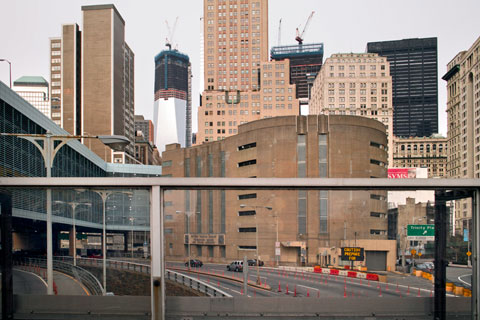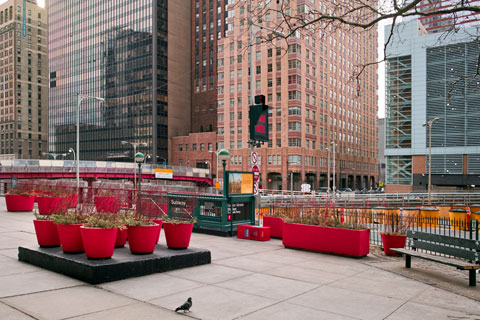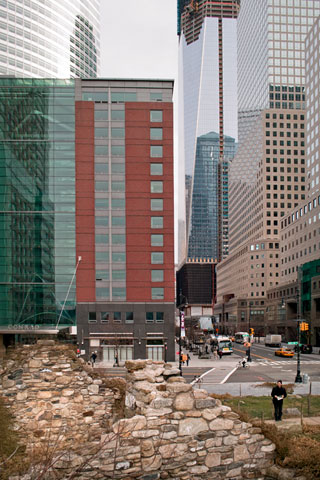
Brooklyn Battery Tunnel entrance — © Brian Rose
David Dunlop in the New York Times City Room column this morning writes about being stopped by MTA security guards while photographing a bus depot in Brooklyn:
The search for lost history leads to odd spots sometimes, like Second Avenue, between 126th and 127th Streets, once the site of William Randolph Hearst’s Cosmopolitan-International movie studio. It is now home to the 126th Street Bus Depot, and that’s what I was taking a picture of last week — from the sidewalk across the avenue — when a property protection agent with the Metropolitan Transportation Authority approached me.
You can’t take pictures of transit facilities, he told me, politely but firmly.
It reminds me of the time I was in East Berlin in 1987 before the Wall came down looking for surviving examples of early 20th century architecture to photograph. At one point, looking for a housing project clearly shown on my map, I found myself standing–with my 4×5 view camera–in front of an enormous complex of buildings with video cameras mounted on the facades–not a common sight in the ’80s. Suddenly, uniformed guards began shouting and approaching. I ducked downstairs into a nearby subway station and made a clean getaway. Later, I realized that I had accidentally stumbled upon the East German Stasi headquarters, the secret police. I was lucky to have escaped.
The truth is I had been photographing for days all over East Berlin using my big camera without being accosted by the many “people’s police” who seemed to be everywhere. Such indifference is not the case in New York City in 2012. Despite recent clarifications of the law and the specific rules regarding photography in public places, I am routinely told by private security guards, police officers, and uncredentialed busy bodies that photography is not permitted. It is, in fact, allowed–even in the subways and buses.
But things are not so simple. A few days ago I took my camera to Lower Manhattan and did a number of photographs relating to my ongoing documentation of the World Trade Center, specifically the rise of 1 WTC, which is replacing the Twin Towers. It was a good day. No one stopped me. In the photograph above I was standing on a pedestrian bridge crossing over the entrance to the Brooklyn Battery Tunnel. I suspect that I was in an area under the jurisdiction of the Port Authority of New York and New Jersey, a public/private authority with its own set of rules. They have stopped me in the past when I made photographs near the Holland Tunnel entrance.

Greenwich Street — © Brian Rose
In the picture above I was standing in a small public plaza adjacent to the tunnel entrance decorated with planters that were probably intended originally for security purposes. The city is littered with such barriers–mostly ugly and obviously ineffective. My guess is that the plaza is under the jurisdiction of the New York City Department of Parks and Recreation, which has its own rules governing photography and the use of tripods.
And in the photograph above I was standing in the Irish Hunger Memorial in Battery Park City under the jurisdiction of the Battery Park City Authority which has its own rules regarding photography and tripods. Another photograph I tried to do recently was from the steps leading up to the Borough of Manhattan Community College which has jurisdiction over its open plaza–I was stopped by a friendly security guard–and another I made was from the Hudson River Park, which is under the jurisdiction of yet another public/private organization. I have no idea what their rules are. Additionally, there are dozens of public plazas that are actually privately owned, the result of crazy zoning deals that award developers with extra floor space in exchange for creating a public amenity. These spaces, like the recently occupied Zuccotti Park, exist in an ever growing twilight zone of public access under private control.
Most of the organizations that have jurisdiction over these spaces are benign in their intentions, but the result, nevertheless, is that they have ultimate control over our public commons and our city. Are we fast becoming a police state?
Update: George Will, of all people, defends photographers’ rights here in the Washington Post.

I didn’t know this; I thought America was the land of freedom. Apparently the right to make photos was not mentioned by the founding fathers ☺. I’ve read the news article; it must be nice for you if a police officer accuses you of making pictures “with no apparent aesthetic value”…
BTW I would love to see photos showing remains of Dutch presence in the 21st century landscape!
Rob,
I’ve had less trouble with police officers than with private security guards, who usually have little training, and often feel the need to assert their authority. Recently had a very nice chat with a young Asian NYPD officer working the area around the WTC. He was interested in what I was doing and promised to look at my website.
The City has very clear guidelines about photography in public places–based on 1st amendment constitutional rights–it is legal as long as one is not blocking sidewalks, etc. Commercial photo shoots that involve equipment, or movie productions, need permits. You can photograph bridges and transportation facilities. The MTA–the subway and bus authority–restricts tripod use, but photography is allowed. Didn’t stop me from getting reprimanded once by a low level MTA employee. The courts have also ruled that one can photograph federal buildings.
Freedom, ultimately–in the U.S. and elsewhere–is not maintained unless one uses it and asserts it. Otherwise, the rights of the people inevitably defer to institutions of authority and power.
Don’t know when or if about photographing the vestiges of Dutch presence, but I’d love to pursue it at some point. Right now, everything is aimed at getting my Lower East Side book out.
Well, even if you were shooed away sometimes, your photos here of Lower Manhattan are very good. We’re glad you maintain your quest for excellence, especially in recording the many changes that happen in our city. We see you mention a book about the Lower East Side — we’ll be looking for its release!